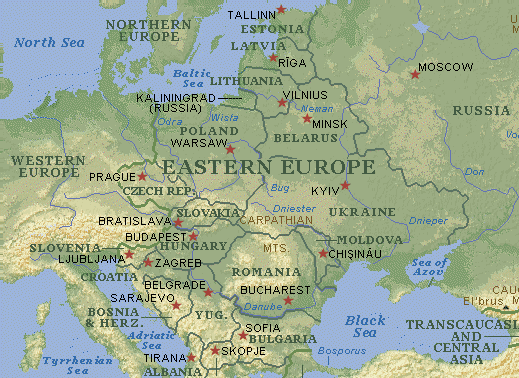|
|
|
![]()
Slavia is know
for its rich association with Vampirism since the very beginning.
Slavians, from Russia, Bulgaria, Serbia, Poland, etc. originated
north of the Black Sea and were closely associated with the
Iranians. Prior to 8th century AD they migrated north and west,
and reside there to current date (2000).

Map of Eastern Europe as it stands today, 2000
Christianisation began almost as soon as they arrived at their new homelands. But through the 9th and 10th centuries the Eastern Orthodox Church and the western Roman Church were struggling with each other for supremacy. They formally broke in 1054 AD, with the Bulgarians, Russians, and Serbians staying Orthodox, while the Poles, Czechs, and Croatians went Roman. This caused a wide split in the development of Vampiric Lore - the Roman church believed incorrupt bodies were saints, while the Orthodox church believed they were vampires.
The origins of
Slavic vampire myths developed during the 9th century as a result
of conflict between pre-Christian paganism and Christianity.
Christianity won out, pushing vampires and other pagan beliefs
into folklore.
Causes of vampirism included being born with a caul, teeth, or
tail; being conceived on certain dates; irregular death;
excommunication; improper burial rituals and so on. The Slavians
used preventative methods at death such as placing a crucifix in
the coffin or putting wooden blocks under the chin to prevent the
body from eating the shroud. Nailing the deceased's clothes to
coffin walls was another technique to stop the deceased from
eating it's shroud.
Families would place millet or poppy seeds in the grave with the
belief that the vampire would count every single one because of a
fascination. If enough seeds were placed then the vampire would
still be counting as the sun rose.
Some families went to the extents of piercing the deceased's body
with thorns or stakes.
Evidence that a vampire was at work in the neighbourhood included
death of cattle, sheep, relatives and neighbours; exhumed bodies
being in a lifelike state with new growth of the fingernails or
hair or if the body was swelled up like a drum; or if there was
blood on the mouth and the corpse had a ruddy complexion.
Vampires could be destroyed by staking, decapitation (the Kashubs
placed the head between the feet), burning, repeating the funeral
service, sprinkling holy water on the grave or exorcism.